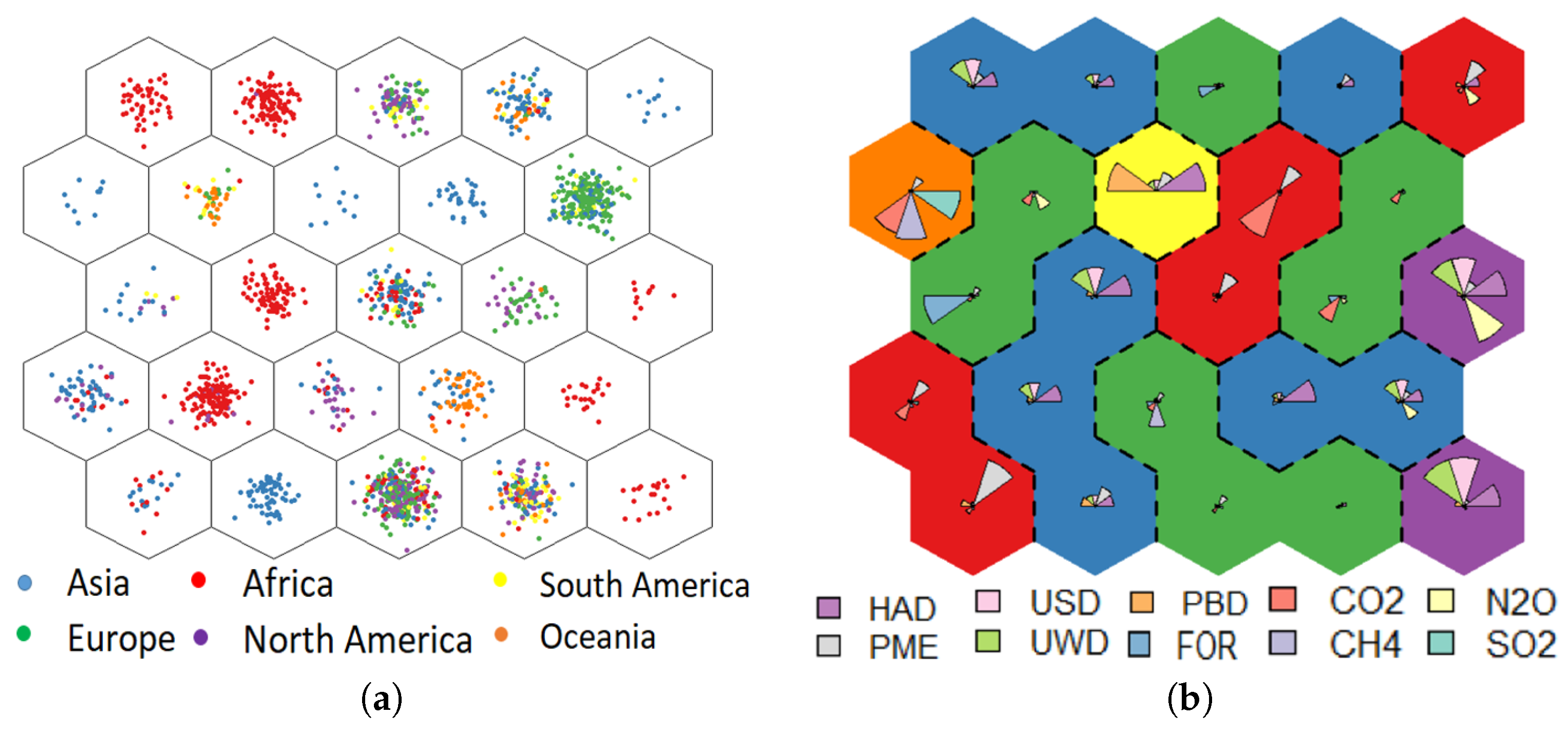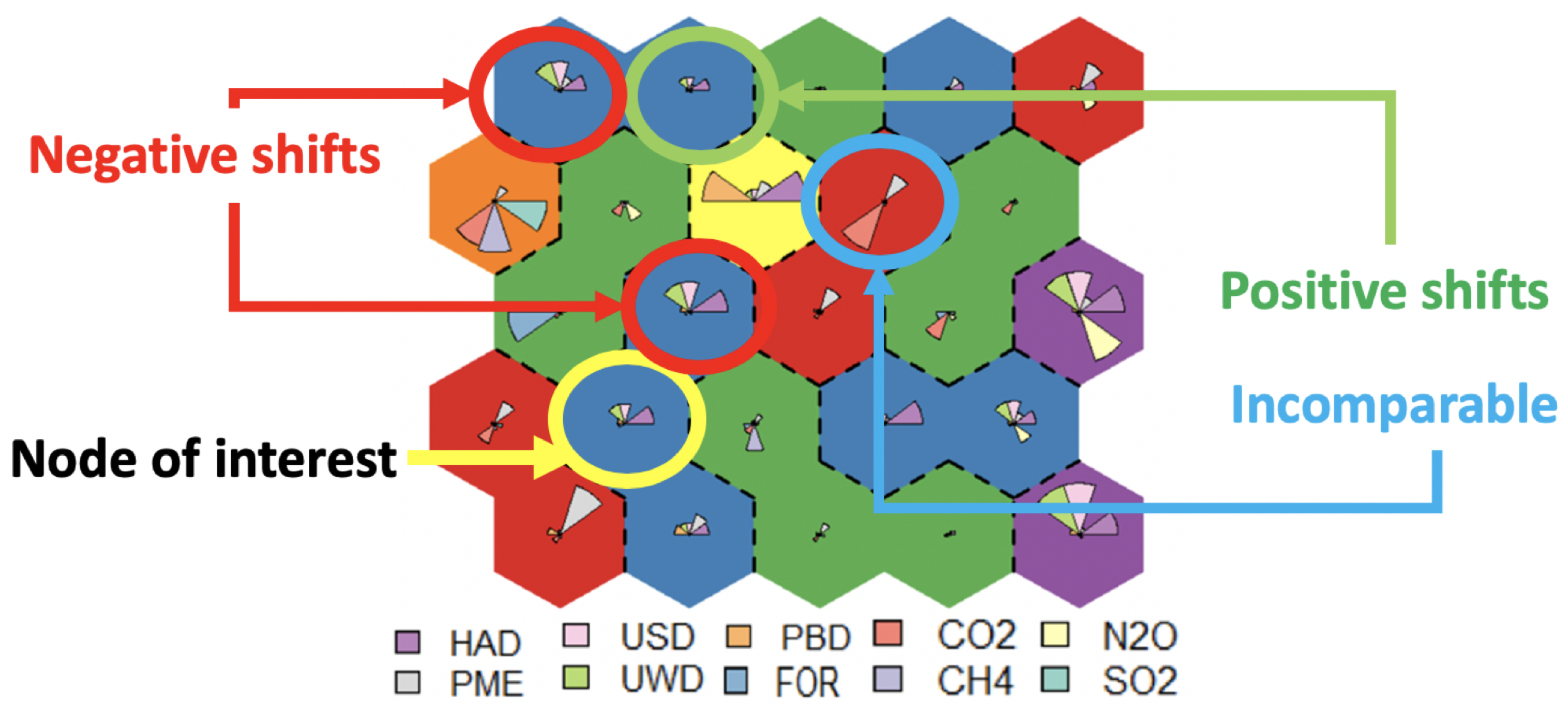Assessing Global Environmental Sustainability Via an Unsupervised Clustering Framework
Abstract
:1. Introduction
2. Data and Methods
2.1. Data Description
2.2. Methodology

3. Results and Discussion
4. Conclusions
Supplementary Materials
Author Contributions
Funding
Conflicts of Interest
References
- World Health Organization; UNICEF. Progress on Drinking Water, Sanitation and Hygiene: 2017 Update and SDG Baselines; World Health Organization: Geneva, Switzerland, 2017. [Google Scholar]
- World Health Organization. 9 out of 10 People Worldwide Breathe Polluted Air; World Health Organization: Geneva, Switzerland, 2018. [Google Scholar]
- Marchese, D.; Reynolds, E.; Bates, M.E.; Morgan, H.; Clark, S.S.; Linkov, I. Resilience and sustainability: Similarities and differences in environmental management applications. Sci. Total Environ. 2018, 613, 1275–1283. [Google Scholar] [CrossRef]
- Wending, Z.A.; Emerson, J.W.; Etsy, D.C.; Levy, M.A.; de Sherbinin, A. 2018 Environmental Performance Index; Technical Report; Yale Center for Environmental Law & Policy: New Haven, CT, USA, 2018. [Google Scholar]
- Böhringer, C.; Jochem, P.E. Measuring the immeasurable-A survey of sustainability indices. Ecol. Econ. 2007, 63, 1–8. [Google Scholar] [CrossRef] [Green Version]
- Barnett, J.; Lambert, S.; Fry, I. The hazards of indicators: Insights from the environmental vulnerability index. Ann. Assoc. Am. Geogr. 2008, 98, 102–119. [Google Scholar] [CrossRef]
- Kaplan, D. Structural Equation Modeling: Foundations and Extensions; Sage Publications: Thousand Oaks, CA, USA, 2008; Volume 10. [Google Scholar]
- Bradshaw, C.J.; Giam, X.; Sodhi, N.S. Evaluating the relative environmental impact of countries. PLoS ONE 2010, 5. [Google Scholar] [CrossRef] [PubMed] [Green Version]
- Kortelainen, M. Dynamic environmental performance analysis: A Malmquist index approach. Ecol. Econ. 2008, 64, 701–715. [Google Scholar] [CrossRef]
- Phillis, Y.A.; Grigoroudis, E.; Kouikoglou, V.S. Sustainability ranking and improvement of countries. Ecol. Econ. 2011, 70, 542–553. [Google Scholar] [CrossRef]
- Charnes, A.; Cooper, W.W.; Rhodes, E. Measuring the efficiency of decision making units. Eur. J. Oper. Res. 1978, 2, 429–444. [Google Scholar] [CrossRef]
- Zanella, A.; Camanho, A.S.; Dias, T.G. Benchmarking countries’ environmental performance. J. Oper. Res. Soc. 2013, 64, 426–438. [Google Scholar] [CrossRef]
- Bi, G.; Luo, Y.; Ding, J.; Liang, L. Environmental performance analysis of Chinese industry from a slacks-based perspective. Ann. Oper. Res. 2015, 228, 65–80. [Google Scholar] [CrossRef]
- Gan, X.; Fernandez, I.C.; Guo, J.; Wilson, M.; Zhao, Y.; Zhou, B.; Wu, J. When to use what: Methods for weighting and aggregating sustainability indicators. Ecol. Ind. 2017, 81, 491–502. [Google Scholar] [CrossRef]
- Burgass, M.J.; Halpern, B.S.; Nicholson, E.; Milner-Gulland, E. Navigating uncertainty in environmental composite indicators. Ecol. Ind. 2017, 75, 268–278. [Google Scholar] [CrossRef]
- Smeets, E.; Weterings, R. Environmental Indicators: Typology and Overview; European Environment Agency: Copenhagen, Denmark, 1999.
- Zuo, X.; Hua, H.; Dong, Z.; Hao, C. Environmental performance index at the provincial level for China 2006–2011. Ecol. Ind. 2017, 75, 48–56. [Google Scholar] [CrossRef]
- Dong, Y.; Hauschild, M.Z. Indicators for Environmental Sustainability. Procedia CIRP 2017, 61, 697–702. [Google Scholar] [CrossRef]
- Robalino, J.D.; Jensen, H.J. Entangled economy: An ecosystems approach to modeling systemic level dynamics. Phys. A Stat. Mech. Appl. 2013, 392, 773–784. [Google Scholar] [CrossRef] [Green Version]
- Vázquez, P.; del Río, J.A.; Cedano, K.G.; van Dijk, J.; Jensen, H.J. Network characterization of the Entangled Model for sustainability indicators. Analysis of the network properties for scenarios. PLoS ONE 2018, 13, e0208718. [Google Scholar] [CrossRef]
- Kohonen, T. Self-organized formation of topologically correct feature maps. Biol. Cybern. 1982, 43, 59–69. [Google Scholar] [CrossRef]
- Forouzanfar, M.H.; Afshin, A.; Alexander, L.T.; Anderson, H.R.; Bhutta, Z.A.; Biryukov, S.; Brauer, M.; Burnett, R.; Cercy, K.; Charlson, F.J.; et al. Global, regional, and national comparative risk assessment of 79 behavioural, environmental and occupational, and metabolic risks or clusters of risks, 1990–2015: A systematic analysis for the Global Burden of Disease Study 2015. The Lancet 2016, 388, 1659–1724. [Google Scholar] [CrossRef] [Green Version]
- SEDAC. For International Earth Science Information Network CIESIN Columbia University, C. In Gridded Population of the World, Version 4 (GPWv4): Population Count; SEDAC: New York City, NY, USA, 2016. [Google Scholar] [CrossRef]
- Hansen, M.C.; Potapov, P.V.; Moore, R.; Hancher, M.; Turubanova, S.; Tyukavina, A.; Thau, D.; Stehman, S.; Goetz, S.; Loveland, T.R.; et al. High-resolution global maps of 21st-century forest cover change. Science 2013, 342, 850–853. [Google Scholar] [CrossRef] [Green Version]
- CAIT Climate Data Explorer. Technical Report; CAIT Country GHG Emissions, Updated 2 October; World Resources Institute: Washington, DC, USA, 2017. [Google Scholar]
- Crippa, M.; Janssens-Maenhout, G.; Dentener, F.; Guizzardi, D.; Sindelarova, K.; Muntean, M.; Van Dingenen, R.; Granier, C. Forty years of improvements in European air quality: Regional policy-industry interactions with global impacts. Atmos. Chem. Phys. 2016, 16, 3825–3841. [Google Scholar] [CrossRef] [Green Version]
- Hastie, T.; Tibshirani, R.; Friedman, J. The Elements of Statistical Learning, 2nd ed.; Springer: New York, NY, USA, 2009; arXiv:1011.1669v3. [Google Scholar]
- Celebi, M.E.; Aydin, K. Unsupervised Learning Algorithms; Springer: New York, NY, USA, 2016. [Google Scholar]
- Nasrabadi, N.M.; Feng, Y. Vector quantization of images based upon the Kohonen self-organizing feature maps. In Proceedings of the IEEE 1988 International Conference on Neural Networks, San Diego, CA, USA, 24–27 July 1988; Volume 1, pp. 101–105. [Google Scholar]
- Taczanowska, K.; González, L.M.; García-Massó, X.; Zięba, A.; Brandenburg, C.; Muhar, A.; Pellicer-Chenoll, M.; Toca-Herrera, J.L. Nature-based Tourism or Mass Tourism in Nature? Segmentation of Mountain Protected Area Visitors Using Self-Organizing Maps (SOM). Sustainability 2019, 11, 1314. [Google Scholar] [CrossRef] [Green Version]
- Mendoza-Carranza, M.; Ejarque, E.; Nagelkerke, L.A. Disentangling the complexity of tropical small-scale fisheries dynamics using supervised Self-Organizing Maps. PLoS ONE 2018, 13, e0196991. [Google Scholar] [CrossRef] [PubMed] [Green Version]
- Mayaud, J.R.; Anderson, S.; Tran, M.; Radić, V. Insights from self-organizing maps for predicting accessibility demand for healthcare infrastructure. Urban Sci. 2019, 3, 33. [Google Scholar] [CrossRef] [Green Version]
- Lu, D.; Tian, Y.; Liu, V.; Zhang, Y. The performance of the smart cities in China—A comparative study by means of self-organizing maps and social networks analysis. Sustainability 2015, 7, 7604–7621. [Google Scholar] [CrossRef] [Green Version]
- Mostafa, M.M. Clustering the ecological footprint of nations using Kohonen’s self-organizing maps. Exp. Syst. Appl. 2010, 37, 2747–2755. [Google Scholar] [CrossRef]
- Tambouratzis, T. An investigation of the environmental sustainability index in terms of its prediction and clustering capabilities. In Proceedings of the IEEE 2014 International Joint Conference on Neural Networks (IJCNN), Beijing, China, 6–11 July 2014; pp. 1784–1791. [Google Scholar]





| Indicator | Description | Source |
|---|---|---|
| HAD | Age-Standardized Disability-Adjusted Life Years (DALY) Lost Due to the Use of House Solid Fuels | [22] |
| PME | Age-Standardized Disability-Adjusted Life Years (DALY) Lost Due to Particulate Matter Emissions | [23] |
| USD | Age-Standardized Disability-Adjusted Life Years (DALY) Lost Due to Lack of Access or Use of Improved Sanitation Facilities | [22] |
| UWD | Age-Standardized Disability-Adjusted Life Years (DALY) Lost Due to Lack of Access or Use of Improved Drinking Water Facilities | [22] |
| PBD | Age-Standardized Disability-Adjusted Life Years (DALY) Lost Due to Lead Exposure | [22] |
| FOR | Tree Cover Loss (hectares) | [24] |
| CO2 | CO2 Emissions (kt) | [25] |
| CH4 | CH4 Emissions (kt of CO2 equivalent) | [25] |
| N2O | N2O Emissions (kt of CO2 equivalent) | [25] |
| SO2 | SO2 Emissions (kt of CO2 equivalent) | [26] |
© 2020 by the authors. Licensee MDPI, Basel, Switzerland. This article is an open access article distributed under the terms and conditions of the Creative Commons Attribution (CC BY) license (http://creativecommons.org/licenses/by/4.0/).
Share and Cite
Paulvannan Kanmani, A.; Obringer, R.; Rachunok, B.; Nateghi, R. Assessing Global Environmental Sustainability Via an Unsupervised Clustering Framework. Sustainability 2020, 12, 563. https://doi.org/10.3390/su12020563
Paulvannan Kanmani A, Obringer R, Rachunok B, Nateghi R. Assessing Global Environmental Sustainability Via an Unsupervised Clustering Framework. Sustainability. 2020; 12(2):563. https://doi.org/10.3390/su12020563
Chicago/Turabian StylePaulvannan Kanmani, Aiyshwariya, Renee Obringer, Benjamin Rachunok, and Roshanak Nateghi. 2020. "Assessing Global Environmental Sustainability Via an Unsupervised Clustering Framework" Sustainability 12, no. 2: 563. https://doi.org/10.3390/su12020563
APA StylePaulvannan Kanmani, A., Obringer, R., Rachunok, B., & Nateghi, R. (2020). Assessing Global Environmental Sustainability Via an Unsupervised Clustering Framework. Sustainability, 12(2), 563. https://doi.org/10.3390/su12020563





